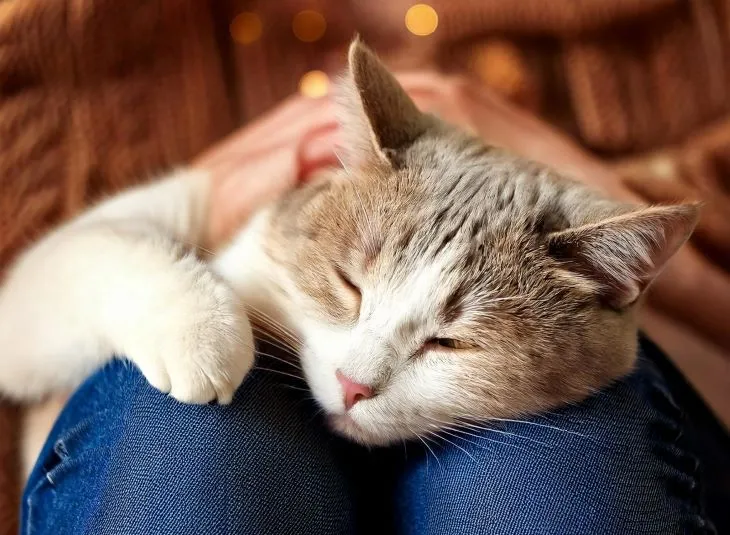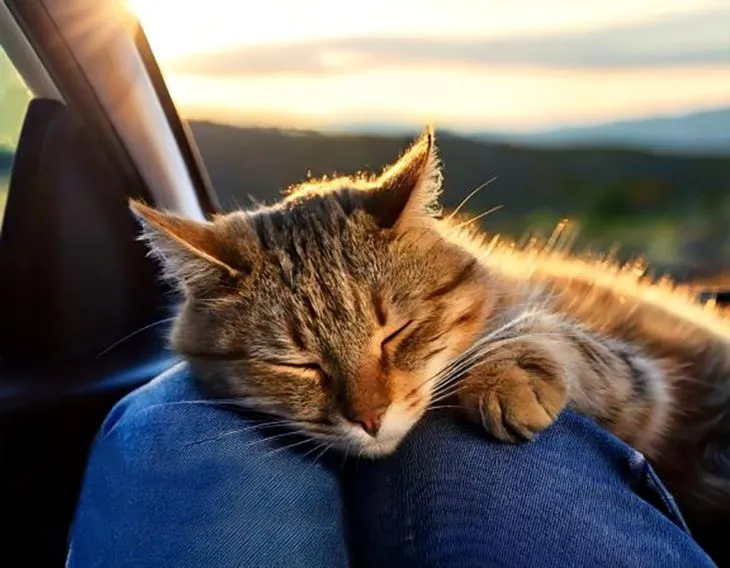Why Does My Cat Sleep Between My Legs? 10 Vet Reviewed Possible Causes
By: Elizabeth Rikas

The information in this article is intended to educate cat parents and is not a substitute for veterinary guidance. In case of any concerns about your cat’s health, please talk with your veterinarian.
Cats have a reputation for quirky, endearing habits, and many pet owners wonder why their feline companions often prefer sleeping in unusual places—like right between their legs. While it may sometimes disrupt your sleep, this behavior often signals a range of positive feelings, from love to a desire for security.
In this article, we’ll explore the different reasons why cats love to sleep between their owner’s legs, what it says about their emotions, the benefits for both of you, and when it may indicate a need for special care. Plus, find expert tips on making co-sleeping with your cat more comfortable.
Why Cats Sleep Between Your Legs: 10 Key Reasons
Many cats enjoy sleeping between their owner’s legs, and it’s not unusual—it’s actually a choice with good reasons behind it. Cats select this cozy spot because it offers several smart benefits.
1. They Feel Safe And Protected
Cats are hardwired to seek security, especially while they sleep. In the wild, they would nestle in hidden, protected spots to avoid predators, so sleeping between your legs feels instinctually safer.
- What this behavior tells you: Cats naturally crave protected environments, and your legs act as a cozy “fort.”
- How this benefits your cat: Sleeping close to you and feeling encased on both sides by your legs offers reassurance and security.
2. Body Warmth And Temperature Control
Cats prefer warmer temperatures than humans, between 86-97°F (30-36°C), which makes the warmth from your body very attractive.
- Fact: A cat’s resting body temperature is higher than that of humans, which explains why they seek warmer spots.
- Pro tip for comfort: Cats tend to gravitate toward your body heat, especially during cooler seasons.
3. They’re Marking Their Territory
Cats have scent glands around their head and paws, allowing them to mark areas they feel attached to, which provides them with a sense of ownership and familiarity.
- What this means: When your cat curls up between your legs, they’re likely marking you with their scent, furthering the bond between you.
- Fun fact: This scent-marking instinct is why you may notice cats rubbing their heads against furniture or people—they’re making you part of their territory!
Click to know: How Many Teeth Do Cats Have?
4. A Show Of Trust And Affection
Cats can be cautious sleepers, as they are more vulnerable while resting. By choosing to sleep so close, they’re demonstrating a high level of trust.
- Behavior insight: Your cat perceives you as a family member and trusts you to keep them safe.
- For cat owners: This behavior is an encouraging sign that your cat sees you as a reliable protector and enjoys your company.
5. Physical And Emotional Comfort
The space between your legs provides your cat with natural support. The steady, rhythmic movement of your breathing is soothing and helps them feel emotionally secure.
- Calming effect: This gentle rise and fall can have a lulling, comforting effect that aids in relaxation.
- Helpful tip: If you’d like to make the experience even more comfortable, consider using a small blanket to provide extra warmth and support.
6. Social Bonding And Companionship
Cats may seem independent, but they form strong social bonds with their owners. Sharing sleep time with you allows them to reinforce this bond and enjoy companionship.
- Why this matters: Studies show that shared experiences, like sleeping close by, can strengthen bonds between pets and humans.
- Encouraging bonding: If you’re open to co-sleeping, let your cat lay between your legs, as this fosters their social needs.
7. Deep Sleep And Relaxation
Cats often enter REM sleep when they feel completely safe, and the position between your legs may promote this deeper level of rest.
- Fact: Cats can sleep up to 15 hours a day, and secure sleep spots help them achieve quality rest.
- What to look for: Cats experiencing REM sleep may twitch or make soft noises; this shows they feel at ease.
8. Stress Relief And Anxiety Management
Some cats sleep close to their owners to manage stress or anxiety. Being close to you can alleviate fears and provide a sense of calm.
- Tip for anxious cats: If your cat has recently experienced stress (e.g., a move or new pet), you may notice them sleeping closer to you for reassurance.
- Extra support: You can help alleviate your cat’s anxiety by maintaining a consistent routine and offering cozy, secure sleeping options nearby.
9. Health And Wellness Benefits
Cats sleeping near their owners offer therapeutic benefits to humans, as well! Their purring can reduce stress, lower blood pressure, and improve relaxation.
- Benefit for you: Physical contact with pets is associated with lower levels of cortisol (stress hormone) and increased oxytocin (the “love hormone”).
- Tip: If their purring relaxes you, you might consider inviting your cat to sleep nearby or on a cozy blanket at your feet.
10. Maintaining A Consistent Routine
Cats are creatures of habit, and they appreciate consistent routines. Sleeping in the same spot, such as between your legs, can become a comforting routine.
- Routine insights: Cats enjoy familiar spots as they help them feel in control of their environment.
- Encouraging routine: If this habit doesn’t interfere with your sleep, consider letting your cat maintain it as it fosters stability.
When To Be Concerned About This Behavior
Although cats sleeping between your legs is generally safe and natural, there are some instances where the behavior could indicate stress or health issues:
- Sudden changes in sleeping preferences: If your cat suddenly insists on sleeping on you when they didn’t before, this could signal anxiety or insecurity.
- Excessive clinginess or resistance to being moved: Cats can become more attached if they feel unwell, so observe any additional signs of distress.
- Signs of discomfort or other behavioral changes: Watch for additional signs, such as increased vocalization, reduced appetite, or grooming changes, as these may indicate a need for a vet visit.
Tips For Comfortable Co-Sleeping With Your Cat

If you enjoy having your cat nearby but want to ensure you both sleep comfortably, here are some tips:
- Provide a Cozy Blanket: A small blanket or towel on your legs can make it more comfortable for your cat and create a designated spot they’re familiar with.
- Temperature Control: Since cats seek warmth, maintaining a warm bedroom may help prevent them from relying solely on your legs.
- Try a Heated Bed: Consider setting up a heated cat bed or a blanket next to your bed as an alternative cozy spot.
- Adjust Your Position: If your cat’s position disrupts your sleep, try shifting them gently onto a nearby pillow or blanket.
- Establish Boundaries: Train your cat gently if you prefer they sleep nearby but not directly on you. Clicker training and positive reinforcement can encourage them to use another space.
Fun Trivia: Can you spot the difference between Male and Female Cats
Final Thoughts
Your cat sleeping between your legs is more than just a quirky habit—it’s a sign of trust, security, and love. While it may be inconvenient at times, understanding the reasons behind this behavior can help you appreciate the special bond you share. Embrace this expression of trust, and remember that if needed, gentle redirection is okay.
Frequently Asked Questions

About the Author
Elizabeth Rikas
Elizabeth is a passionate advocate for feline health and well-being, drawing from her years as a dedicated pet parent to three cats—Gypsy, Swan, and Alfred—and her invaluable experience volunteering at animal shelters. A seasoned writer with a lifelong love for cats, Elizabeth began sharing her insights in her teens and has since contributed extensively to platforms focused on feline care. Through her expertise and heartfelt dedication, she empowers pet owners with practical advice and research-backed knowledge to nurture their furry companions.
